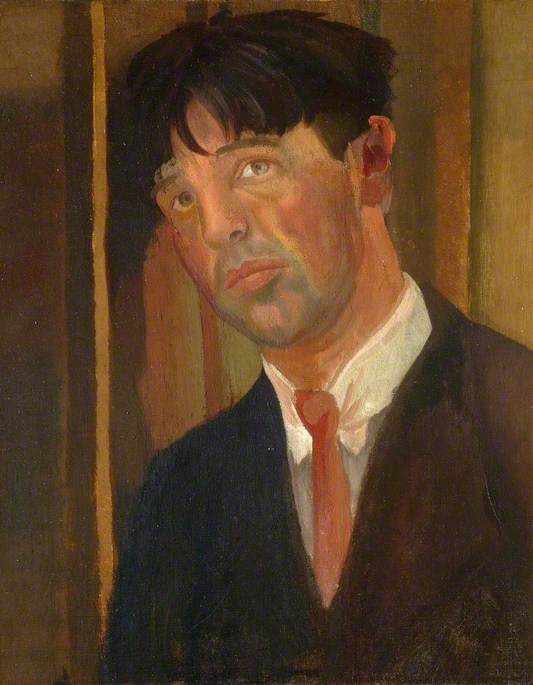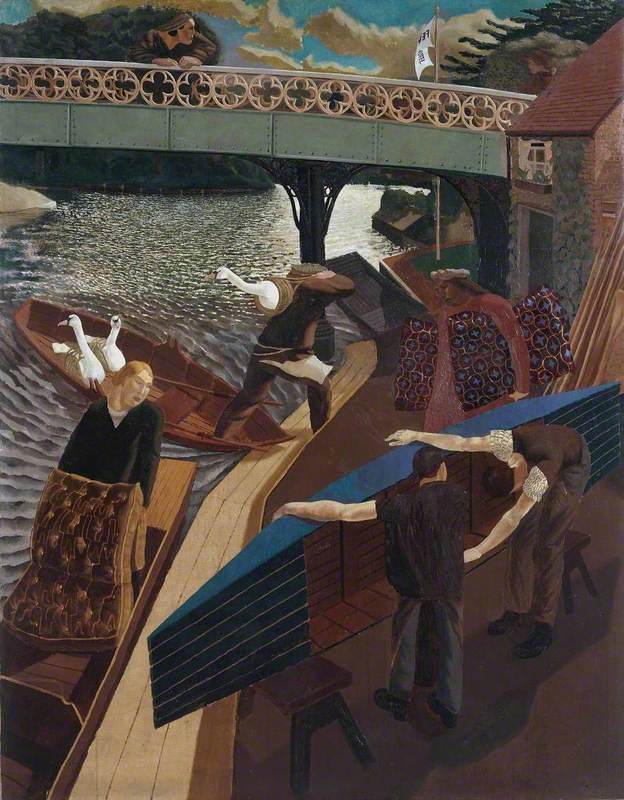The Stanley Spencer Gallery is devoted to the work of one of Britain’s greatest painters, and is situated in Cookham where he was born and spent much of his working life. The village became the source of spiritual and artistic inspiration for the artist. The Gallery opened in 1962 in the former Methodist chapel where he worshipped as a child, and has the largest selection of Spencer’s works permanently on display.
Art Unlocked is an online talk series by Art UK in collaboration with Bloomberg Philanthropies. This Curation is based on a talk by Amanda Bradley, Chair of Exhibitions Committee & Trustee at the Stanley Spencer Gallery, on 1st September 2021. You can find a recording at https://youtu.be/vjrmOr43r7E
-
Self Portrait 1923
Stanley Spencer (1891-1959) and his work have become synonymous with Cookham, where he was born. This Berkshire village became the source of his religious, emotional and artistic wellbeing. He was even nicknamed ‘Cookham’ while he was studying at the Slade School of Art (1908-12).
This portrait was painted a year after he become engaged to a fellow artist, Hilda Carline. In 1923 Spencer wrote to his fiancée that ‘[he was] doing a self-portrait, which will not be any good, I am afraid, as I have my head in such a position as hardly to be able to see what I am painting.’ He appears to show his head resting on a door which would indeed have been a difficult angle from which to paint. The paint has been used in a broad Gauguin-esque manner.
Stanley Spencer (1891–1959)
Oil on canvas
H 50.8 x W 40.6 cm
Stanley Spencer Gallery
-
The Last Supper 1920
Spencer has characteristically placed this biblical episode in his own environment – a Cookham malthouse. The painting was installed as an altarpiece in a private chapel belonging to Henry and Margaret Slesser. They lived in Bourne End which was sufficiently close to Spencer’s home in Cookham for he and his brother to bound across there ‘with their pyjamas in their pockets’. Spencer’s planar use of colour is derived from the Early Renaissance artist Giotto (1267-1337); his passion for Italian Primitives had been inspired by Roger Fry’s lectures at the Slade. The use of red and white in the composition mirrors the symbolism of the bread and wine being distributed by Christ, and his impending sacrifice.
Stanley Spencer (1891–1959)
Oil on canvas
H 112.6 x W 145.2 cm
Stanley Spencer Gallery
 © the estate of Stanley Spencer. All rights reserved / Bridgeman Images. Image credit: Stanley Spencer Gallery
© the estate of Stanley Spencer. All rights reserved / Bridgeman Images. Image credit: Stanley Spencer Gallery
-
Sarah Tubb and the Heavenly Visitors 1933
Spencer has painted Granny Tubb (modelled by her daughter Sarah) sinking to her knees in Cookham High Street. At the sight of a spectacular sunset caused by Halley’s Comet, she was convinced the apocalypse was nigh. She is presented with ‘emblems of what she is like’ and ‘all those things she loved’ by heavenly beings. Spencer described the scene as ‘a sort of apotheosis of the old lady’. It was painted as part of Spencer’s Church House project (conceived between 1932 until his death) which was an unrealised monument to his life and loves. This painting demonstrates how the themes of love, religion and Cookham were inextricably entwined for the artist. It was probably intended for a Pentecost series, where angels and saints visit Cookham.
Stanley Spencer (1891–1959)
Oil on canvas
H 108.9 x W 119 cm
Stanley Spencer Gallery
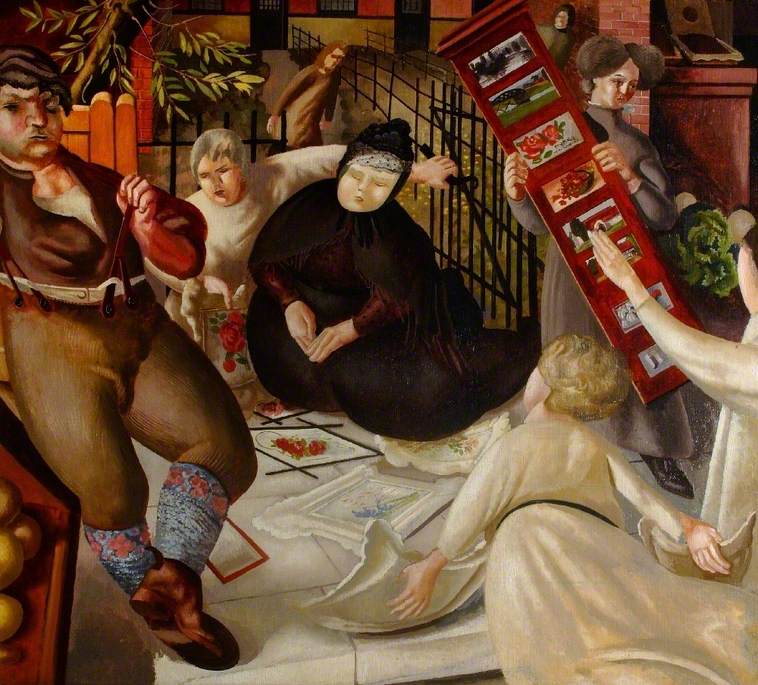 © the estate of Stanley Spencer. All rights reserved / Bridgeman Images. Image credit: Stanley Spencer Gallery
© the estate of Stanley Spencer. All rights reserved / Bridgeman Images. Image credit: Stanley Spencer Gallery
-
At the Chest of Drawers 1936
Part of Spencer’s Domestic Scenes series, this painting was one of nine pictures celebrating ‘the special joy and significance’ of moments in his relationship with his first wife, Hilda Carline. A physically overwhelming Hilda is shown leaning over the diminutive Spencer, as together they look through a chest of drawers, from which collars spill out. Although this was painted in the run-up to his divorce from Hilda in 1937, Spencer has memorialised and idealised his failing marriage. Only days after the divorce, he married Patricia Preece with whom he had become obsessed. Their marriage failed from the first day and was never consummated. That relationship was immortalised in Spencer’s avant-garde series of nude studies of Patricia.
Stanley Spencer (1891–1959)
Oil on canvas
H 50.8 x W 66 cm
Stanley Spencer Gallery
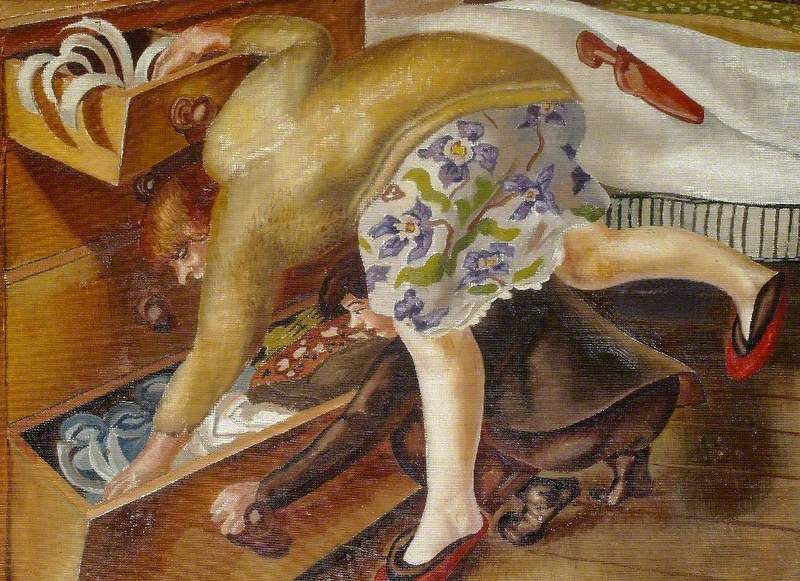 © the estate of Stanley Spencer. All rights reserved / Bridgeman Images. Image credit: Stanley Spencer Gallery
© the estate of Stanley Spencer. All rights reserved / Bridgeman Images. Image credit: Stanley Spencer Gallery
-
The Beatitudes of Love (5): Contemplation 1938
A series of eight paintings called The Beatitudes of Love were painted after the breakdown of Spencer’s marriage. Destined for the Church House project, they are more intimate or sexually orientated than the Domestic Scenes. Many of the pictures have stories attached, the narrative obscuring Spencer’s own emotional desolation. Spencer described the cluster of figures in Contemplation as having a ‘rapt gaze, as though they would never stop looking’. Many of the figures are grotesquely proportioned – a feature of Spencer’s work when he was working from his imagination. He maintained that ‘whatever that outward appearance may be it is an exquisite reminder of what is loved within, no matter what that exterior appearance may be.'
Stanley Spencer (1891–1959)
Oil on canvas
H 91.4 x W 61 cm
Stanley Spencer Gallery
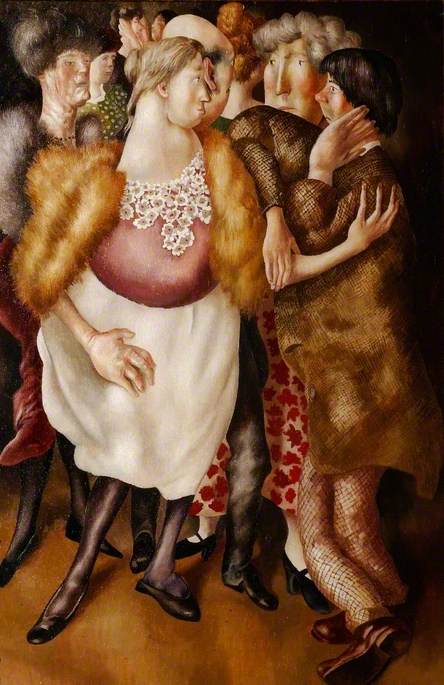 © the estate of Stanley Spencer. All rights reserved / Bridgeman Images. Image credit: Stanley Spencer Gallery
© the estate of Stanley Spencer. All rights reserved / Bridgeman Images. Image credit: Stanley Spencer Gallery
-
Self Portrait 1959
This presentation sketch was drawn in the final months of Spencer’s life, when the artist was dying of cancer. He used loose, parallel hatching in the background but on the face he has created depth and contrast with tight cross-hatching, a technique typical of Michelangelo. It is an unnerving image, with the artist gazing directly at the viewer, his gaunt, weathered face overwhelmed by the frame of his glasses. The sketch is a thought-provoking document of Spencer’s physical and mental state before he died. Spencer’s friend, Joy Smith, had commissioned him to paint a self-portrait. She had wanted an oil and did not find the drawing a true likeness, so he was encouraged to revisit the exercise, resulting in the canvas which is now at Tate.
Stanley Spencer (1891–1959)
Red Conté crayon on paper
H 53.7 x W 35.7 cm
Stanley Spencer Gallery
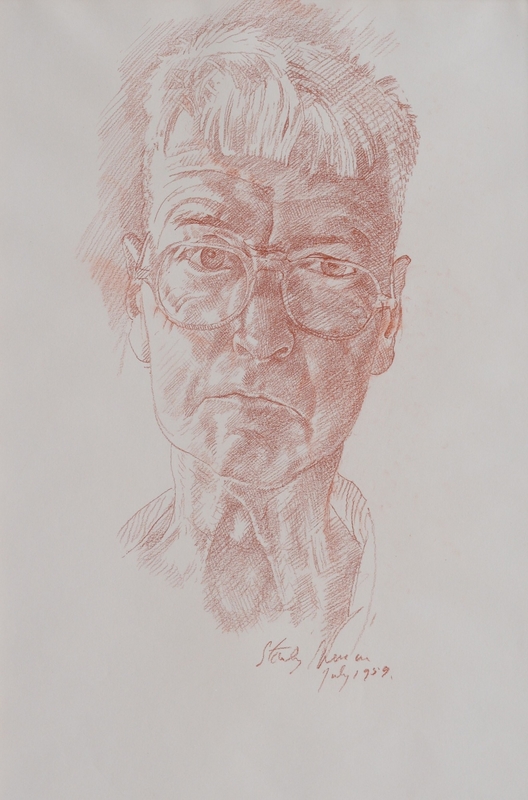 © the estate of Stanley Spencer. All rights reserved / Bridgeman Images. Image credit: Stanley Spencer Gallery
© the estate of Stanley Spencer. All rights reserved / Bridgeman Images. Image credit: Stanley Spencer Gallery
-
Art Unlocked: Stanley Spencer Gallery
